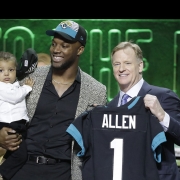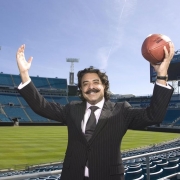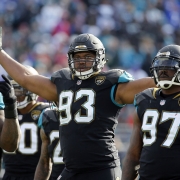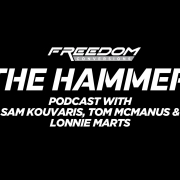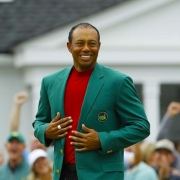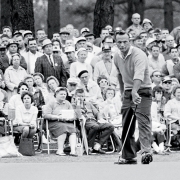Jaguars Take Allen, Easy Pick
When you pick a player in the first round of the NFL Draft, you expect him to step in a be a starter for ten years. That’s what first round talent is supposed to be: solid, reliable and sometimes spectacular.
But despite the millions of dollars spent and the millions of man-hours dedicated to the draft, it remains an inexact science. There wasn’t a personnel director or draft guru who didn’t think Josh Allen was a top five pick in this year’s draft.
And yet, when the Jaguars were on the clock with the seventh pick, Allen was still there.
The Raiders, as predicted, did something weird with their pick at #4, taking Clelin Ferrell from Clemson. That left Allen as the far and away best player still on the board for the Jaguars.
Which made it an easy selection.
This was not a reach.
Unlike many of the Jaguars first round picks in the last fifteen years, Josh Allen was the best player on the Jaguars board. They wasted no time calling him and turning the card into the NFL. That’s why less than two minutes had gone by in the Jaguars draft window when the sign went up, “The pick is in.”
It was like the Jalen Ramsey pick three years ago. When the Cowboys took Ezekiel Elliott right before the Jaguars were “on the clock,” GM Dave Caldwell wasted no time calling Ramsey and making the pick.
Why wait when you’re getting one of the best players in the draft?
Yes, Executive VP Tom Coughlin said they were high on tight ends and offensive lineman in that spot but this was a no-brainer.
Unless Quinnen Williams, the defensive lineman from Alabama, whom the Jaguars thought was the best player in the whole draft, fell to them, Allen was an easy selection for the Jaguars when he got past the Jets and the Giants and even the Bucs. They never thought he’d be there.
“Too good of a football player to pass up. A superior player,” said Executive VP Tom Coughlin. “In all of our scenarios, he was already gone.”
Taking Allen, as unexpected as it was, is a very “Jaguars” pick under Coughlin. Last year’s selection of Taven Bryan seems like an aberration, a reach, even a pick based on hubris rather than careful study.
Allen is a football player, not some combine freak or just an athlete who’s playing football. Fifty-one games in college, 35 starts, first team All-America and plenty productive. Defensive player of the year and 17 sacks his senior year. That’s the most by an SEC player since the NCAA started keeping the stat. Didn’t miss a game in his entire college career.
And Allen seems to be thrilled to be with the Jaguars, a team self-described as committed to defense and running the football.
“They get after the quarterback.,” Allen said of the Jaguars emphasis on defense. “That’s all I need to hear. I went there on my visit and they said, ‘Josh, we get after the quarterback.’ I love getting after the quarterback.”
Regrettably for the Jaguars since 2003, their first round picks have been rarely been solid, reliable, and almost never spectacular. Only one, Marcedes Lewis, lasted 10 years with the Jaguars. Reggie Nelson and Tyson Alualu have had extended NFL careers. But Byron Leftwich, Reggie Williams, Matt Jones, Derrick Harvey, Eugene Monroe, Blaine Gabbert, Justin Blackmon, Luke Joeckel and even Blake Bortles and Dante Fowler have been part of an extended period of futility. The only star is Jalen Ramsey. The jury is out on Leonard Fournette and Taven Bryan.
“The best player in the draft,” Ramsey said on his Twitter feed.
This is not a pick made from hubris. This is a solid, football pick. Even if Allen doesn’t become a superstar, he’s going to be a good NFL player.
And the Jaguars need those. Too many times they’ve had picks that have a high ceiling, but also a very low floor. Allen’s physical abilities as a football player seem to have a high ceiling. His attitude about life and achievement seem to keep him from sinking to a lower level. He came back for his senior year at Kentucky for all the right reasons.
“I think about it every day. I would have never been in this situation last year,” he said. “I decided I am glad I came back to further myself as a person and as a player, as well.”
I’m sure Coughlin is sick and tired of hearing about R.J. Soward and the other draft picks that didn’t work out during his tenure with the Jaguars and the Giants. But he did build contending teams in both places and won two Super Bowls with the Giants.
You can’t use revisionist history and say they should have taken Ben Roethlisberger or Terrell Suggs without the context of the moment. The Steelers cut John Unitas and teams passed on Tom Brady 198 times before the Patriots took him in the 6th round. They’re the best two quarterbacks in the game’s history.
It’s easy to cherry pick the mistakes teams have made in the draft from Ryan Leaf and Tony Mandarich on down.
This isn’t one of them.

